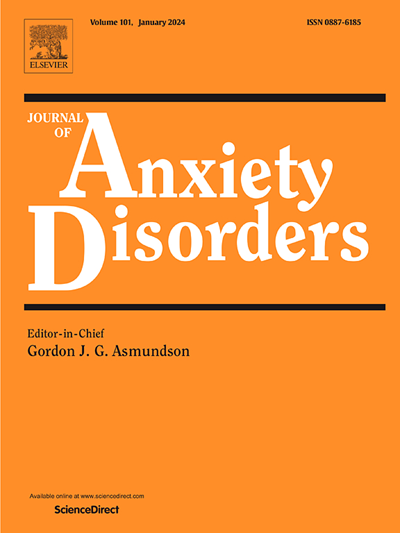Covert or connected: Motivations for online and interpersonal reassurance-seeking in OCD
IF 4.5
2区 医学
Q1 PSYCHIATRY
引用次数: 0
Abstract
Interpersonal reassurance-seeking is a common anxiety-management strategy used by individuals with a range of disorders, but can be particularly repetitive and exacting among individuals with obsessive-compulsive disorder (OCD). Although this strategy yields short-term relief, it also comes at a cost, creating frustration and straining relationships. Non-interpersonal sources of reassurance—such as the internet—have been less thoroughly studied, but may offer unique advantages. In this mixed-methods study, we explored the differentiating benefits and drawbacks of interpersonal and online reassurance-seeking for individuals with and without OCD. Participants (n = 62 OCD, n = 58 control) completed an imaginal exposure task, after which they indicated their reassurance source preference (interpersonal vs. online) and their primary reasons for this preference. Participants also answered two general questions about their usual motivations for seeking reassurance from each source at the exclusion of the other. We used content analysis to identify patterns in participants’ responses, and quantitative methods to examine the most common motivations as well as any between-group differences. Common reasons for seeking reassurance interpersonally included desires for emotional support and personalization, and these findings did not differ between groups. Common reasons for online reassurance typically involved interpersonal concerns, and participants with OCD were more likely to specifically express concern about the personal consequences of revealing one’s worries to others. Motivations related to trust and seeking shared experiences were common for both reassurance types. These findings are discussed in the context of the broader literature on reassurance-seeking and obsessive-compulsive symptomatology.
隐蔽或联系:强迫症患者在线和人际安慰寻求的动机
寻求人际安慰是一种常见的焦虑管理策略,用于各种障碍患者,但对于强迫症患者来说,这种策略可能特别重复和严格。尽管这种策略能带来短期的缓解,但它也有代价,会造成挫败感和关系紧张。非人际关系来源的安慰——比如互联网——研究得不太彻底,但可能具有独特的优势。在这项混合方法的研究中,我们探讨了有强迫症和没有强迫症的个体在人际和网络安慰寻求方面的不同利弊。参与者(n = 62强迫症患者,n = 58对照组)完成了一项图像暴露任务,之后他们表明了他们对保证来源的偏好(人际与网络)以及他们这种偏好的主要原因。参与者还回答了两个一般性问题,即他们在排除其他来源的情况下,从每个来源寻求安慰的通常动机。我们使用内容分析来确定参与者的反应模式,并使用定量方法来检查最常见的动机以及任何组间差异。在人际关系中寻求安慰的常见原因包括对情感支持和个性化的渴望,这些发现在两组之间没有差异。网上安慰的常见原因通常与人际关系有关,患有强迫症的参与者更有可能明确表达对向他人透露自己担忧的个人后果的担忧。与信任和寻求共同经历相关的动机在两种保证类型中都很常见。这些发现在更广泛的安心寻求和强迫症症状学文献的背景下讨论。
本文章由计算机程序翻译,如有差异,请以英文原文为准。
求助全文
约1分钟内获得全文
求助全文
来源期刊

Journal of Anxiety Disorders
Multiple-
CiteScore
16.60
自引率
2.90%
发文量
95
期刊介绍:
The Journal of Anxiety Disorders is an interdisciplinary journal that publishes research papers on all aspects of anxiety disorders for individuals of all age groups, including children, adolescents, adults, and the elderly. Manuscripts that focus on disorders previously classified as anxiety disorders such as obsessive-compulsive disorder and posttraumatic stress disorder, as well as the new category of illness anxiety disorder, are also within the scope of the journal. The research areas of focus include traditional, behavioral, cognitive, and biological assessment; diagnosis and classification; psychosocial and psychopharmacological treatment; genetics; epidemiology; and prevention. The journal welcomes theoretical and review articles that significantly contribute to current knowledge in the field. It is abstracted and indexed in various databases such as Elsevier, BIOBASE, PubMed/Medline, PsycINFO, BIOSIS Citation Index, BRS Data, Current Contents - Social & Behavioral Sciences, Pascal Francis, Scopus, and Google Scholar.
 求助内容:
求助内容: 应助结果提醒方式:
应助结果提醒方式:


